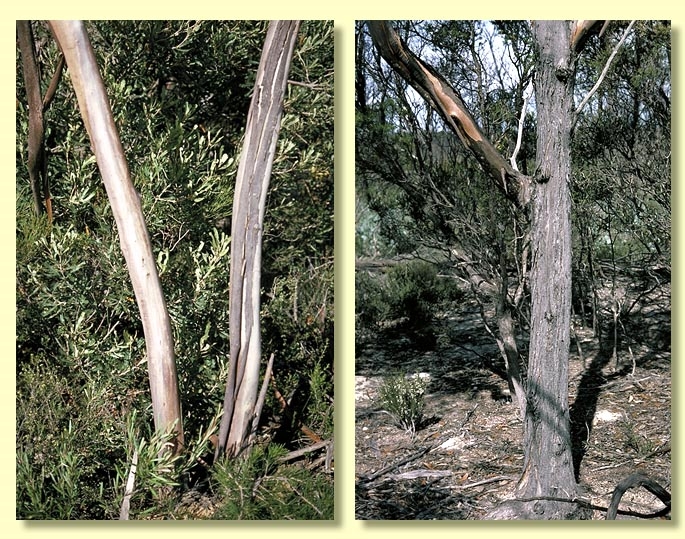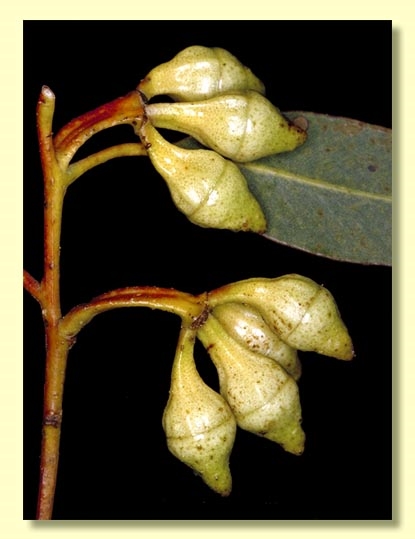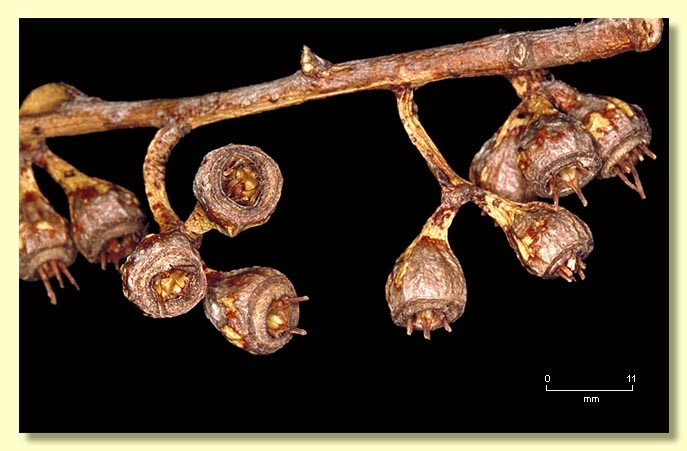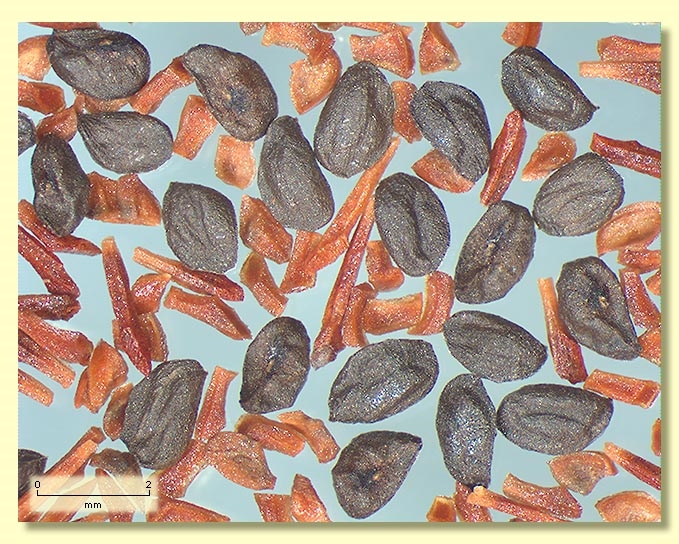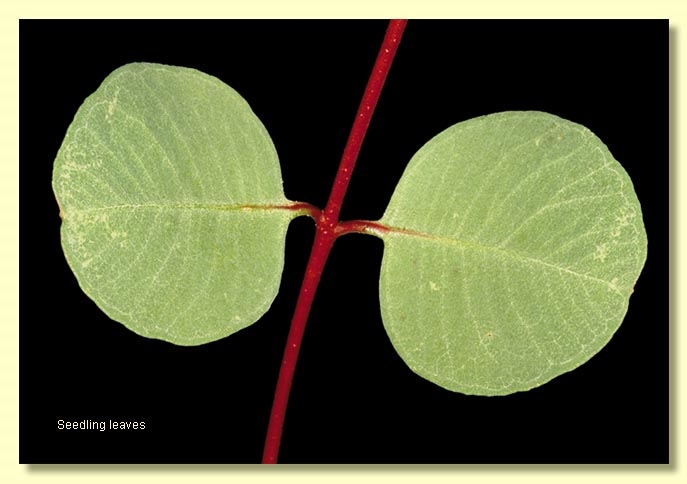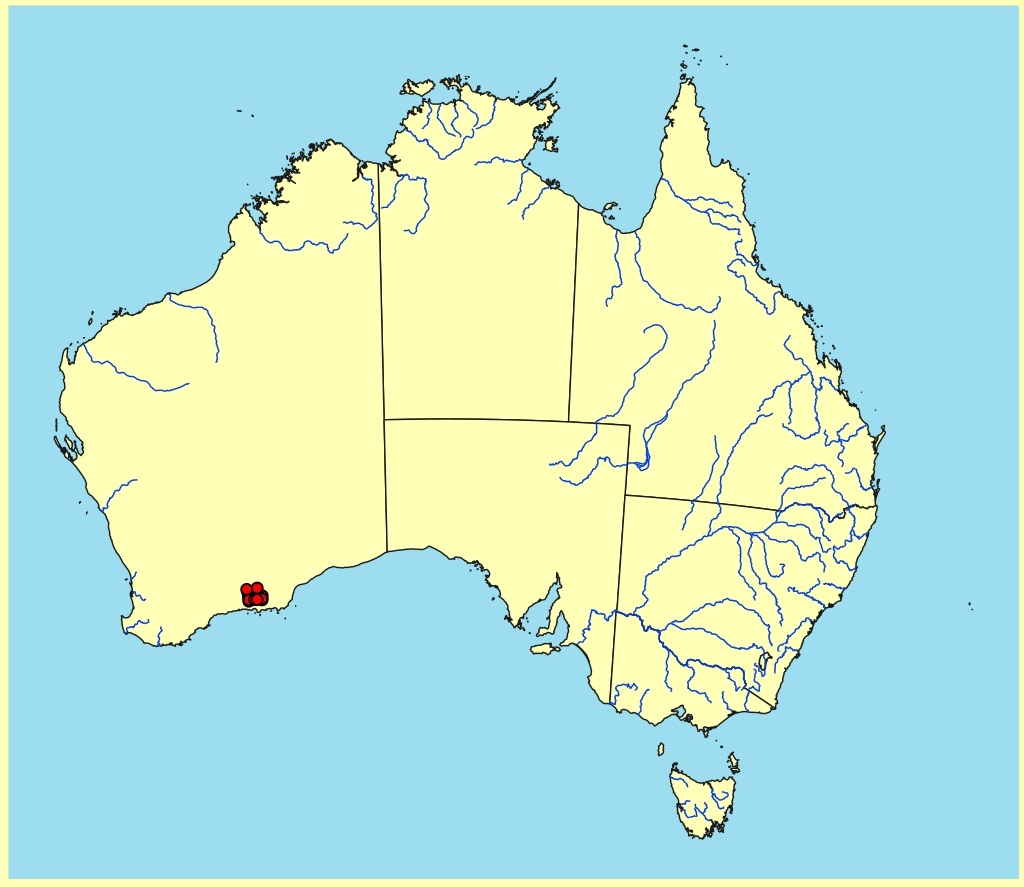Euclid - Online edition
Eucalyptus kessellii subsp. kessellii
Eucalyptus | Symphyomyrtus | Bisectae | Destitutae | Falcatae | Rugatae
T: Salmon Gums, 66 miles N of Esperance, W.A., W.P.Brown per C.A.Gardner 994a; holo: NSW 345072 (this has collection date "Aug 1924"); iso: PERTH 01007726 (this has collection date "25 May 1924").
Mallee to 10 m tall or rarely a tree . Forming a lignotuber.
Bark rough, very hard and grey-brown to blackish over lower part of trunk, or smooth throughout on smaller mallees, smooth bark grey-brown and pale brown to pink-orange.
Branchlets lacking oil glands in the pith.
Juvenile growth (coppice or field seedlings to 50 cm): stems rounded to square in cross-section, never glaucous; juvenile leaves always shortly petiolate, opposite for ca 5 nodes then subopposite, lower leaves ovate but becoming orbicular, 3–9 cm long, 4–9 cm wide (ratio length:width between 1.0 and 1.4), base usually truncate, margin entire, apex rounded and mucronate or emarginate, dull, grey-green.
Adult leaves thick, alternate, petioles 1.5–4.1 cm long; blade lanceolate to ovate, 7–14.5 cm long, 1.5–3.5(5) cm wide, base tapering to petiole, margin entire, apex acute, concolorous, green rarely greyish green, usually glossy, side-veins at an acute or wider angle to midrib, with dense to very dense reticulation, intramarginal vein remote from margin, oil glands irregular, intersectional.
Inflorescence axillary unbranched on down-turned, very broad, flat peduncles 1–2.5 cm long, buds 3(7) per umbel, sessile or pedicellate (pedicels 0–0.7 cm long). Mature buds diamond-shaped to ovoid (1.1–1.8 cm long, 1.1–1.3 cm wide), cream, usually with 8–12 prominent ribs (ribs > 1 mm high), scar present (outer operculum shed early in bud development), operculum conical or slightly beaked, stamens inflexed, anthers cuboid, versatile, sub-basifixed, dehiscing by longitudinal slits, style long and straight, stigma blunt to rounded, locules 4 or 5, the placentae each with 4 vertical rows of ovules. Flowers creamy white or pale yellow.
Fruit rigidly downturned, pedicellate (pedicels 0–0.7 cm long), obconical to cupular, shallowly to prominently ribbed, 1.1–1.7 cm long, 1.1–2.1 cm wide (including ribs), rim thick, inner edge of staminophore raised in the mature fruit, disc level in outer part but then descending vertically (but may be hidden by persistent staminophore), valves 4 or 5, prominently exserted but fragile.
Seeds grey, 1.5–2.5 mm long, ovoid or flattened-ovoid, dorsal surface very shallowly reticulate and often furrowed, hilum ventral.
Cultivated seedlings (measured at ca node 10): cotyledons Y-shaped (bisected); stems rounded in cross-section; leaves always shortly petiolate, opposite to sub-opposite for at least 13 nodes, linear for 1 or 2 nodes then ovate up to ca node 6 then becoming orbicular, (1.5)2–8 cm long, (1.5)2–7.5 cm wide (ratio length:width between 1.0 and 1.2), base rounded to tapering, margin entire, apex emarginate or rounded and apiculate, dull, green.
Flowering has been recorded in August, September, October and November.
A mallee or small tree species endemic to Western Australia, of southerly subcoastal distribution east from the Ravensthorpe Range to Condingup, inland to Salmon Gums and Mt Ney, in mallee woodland and mallee heath communities on sandy to sandy-clay soils. Larger plants develop hard, rough, thick, dark greyish bark on the lower part of the trunks but smaller trees and most mallees have completely smooth bark. The adult leaves are glossy, green and buds cream coloured.
There are two subspecies:
E. kessellii subsp. kessellii has a more inland distribution from Salmon Gums east and south-east towards Mount Ney. It has buds in umbels of predominately 3, with well-developed ribs >1 mm high on buds and fruit.
E. kessellii subsp. eugnosta occurs in areas closer to the coast from Ravensthorpe and Jerdacuttup extending to the east of Esperance as far as Boyatup, Condingup, and inland to Cascades and Grass Patch and to the Mount Ney area. It has buds predominately in 7s, with less well developed ribbing always < 1 mm high on buds and fruit.
In the classification of Brooker (2000) Eucalyptus kessellii belongs in Eucalyptus subgenus Symphyomyrtus section Bisectae subsection Destitutae because buds have two opercula, cotyledons are Y-shaped and branchlets lack oil glands in the pith. Within this subsection E. kessellii belongs to a group of twelve species characterised by usually pendulous inflorescences with pedicellate ovoid buds with a conical to beaked operculum, obconical to cupular fruits with exserted fragile valves and adult leaves that are green, densely reticulate and have numerous intersectional oil glands. The species are the mallets E. falcata, E. ornata, E. purpurata, E. recta, and E. rugulata, and the mallees E. dorrienii, E. ecostata, E. petrensis, E. opimiflora, E. goniantha (with two subspecies), E. notactites,E. kessellii (with two subspecies), which together form series Falcatae subseries Rugatae .
Eucalyptus kessellii is distinctive in subseries Rugatae because it has stout diamond-shaped buds in umbels of three or seven on rigidly down-turned broad flattened peduncles. The buds are ribbed and noticeably cream-coloured at maturity. It flowers profusely. It is most likely to be confused with another related species of the southern coast from Albany to Condingup, E. goniantha, but that species has narrower elongate or rounded buds with less ribbing (in subsp. goniantha ), held on more slender peduncles that are spreading to almost erect in the leaf axils; E. goniantha subsp. kynoura has similar coarsely ribbed fruit to E. kessellii subsp. kessellii but can be distinguished by the more slender peduncles, buds with relatively longer blunt operculum and coastal cliff habitat. E. notactites differs in its sessile almost ribless buds which occur in umbels of 11 up to 19. Other related mallee species (E. dorrienii , E. ecostata, E. petrensis, E. opimiflora) and mallet species (E. falcata, E. purpurata, E. rugulata, E. recta, E. ornata ) have ribbed or scarcely ribbed buds that are usually gracefully pendulous on slender peduncles and pedicels.


